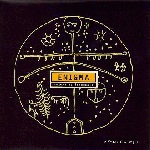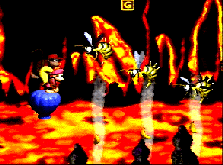Movie History: The Last Days of Planet EarthMany of you may remember catching glimpses of this one very late at night on Channel [insert number greater than 19 here], and now that it's been picked up by TNT, expect to see it even more often. And for the first time, I actually caught some of the beginning, too, though, from the way it was going (giant vampire bats attacking explorers who have to shoot members of their party reduced to zombies) I thought it was Attack of the Mushroom People or that one Japanese King Kong movie with the villainous "Dr. Who." What do you expect from Toho, I suppose--some of the footage looks recycled from Godzilla flicks.
There's a story being told, that much is certain, end of the world, pregnant woman defies doomsday, etc., but I'm inclined to agree with a novel interpretation that I recently read on the Web, that this is one man's nightmare realized. In that sense, you might even say that this otherwise forgettable film inspired the great Akira Kurosawa to present his own Dreams. You might. I still don't understand the scene with the hippies partying behind the kids quietly eating sushi. And I swear, one of the motorcyclists jumping their bikes off the cliff in slo-mo hit a rock below before landing in the water. Be sure to look for it.
The Last CD I Bought: Enigma "Return to Innocence"
 The song's almost three years old, and the whole chant-dance fad's even older, but having only recently been reminded of it by its incorporation into a syndicated episode of the made-for-Showtime anthology series The Outer Limits, I had quite a hard time tracking down a copy of this one. (Where do I finally run into it, but at Sam Goody's in Universal Studios CityWalk, a garish, nightmarish tourist attraction whose only real connection to the movies for me was the price of the food and drink.) "The Conversion" was Rebecca de Mornay's showcase, with her directing and guest-starring as an intergalactic angel in a corny Christmas story which whose elements--including the postive, cosmic message of its soundtrack--first struck me as making for unwatchable television, even to me, but managed to move my trampled-on soul.
The song's almost three years old, and the whole chant-dance fad's even older, but having only recently been reminded of it by its incorporation into a syndicated episode of the made-for-Showtime anthology series The Outer Limits, I had quite a hard time tracking down a copy of this one. (Where do I finally run into it, but at Sam Goody's in Universal Studios CityWalk, a garish, nightmarish tourist attraction whose only real connection to the movies for me was the price of the food and drink.) "The Conversion" was Rebecca de Mornay's showcase, with her directing and guest-starring as an intergalactic angel in a corny Christmas story which whose elements--including the postive, cosmic message of its soundtrack--first struck me as making for unwatchable television, even to me, but managed to move my trampled-on soul.
Current Favorite Tune: Grantby "Timber"
Described as a "space-age Sixties spy movie soundtrack," Sean Connery does indeed come to mind when listening to this little-known British instrumental, but unlike Adam Clayton's recent Mission: Impossible theme adaptation, which was about as exciting as Billy Idol doing "Mony Mony" or, worse, the Thompson Twins singing "(Say You Want a) Revolution," it captures the spirit of a simpler time while incorporating something of today other than commercial cool. Even with its seven-minute-plus length, this is one piece of music I wish'd go on forever. (And maybe, with the help of friends who have been telling me that they've converted their computers into full-blown mixing studios with their MIDI-thingamabob and WaveTable-doohickey, I might do just that....)
Reviews: Super Mario World 2/Donkey Kong Country 2 (Super NES)
 The videogame world these days is buzzing with 32-bit fever: the Sony PlayStation and the Sega Saturn,
with their state-of-the-art CD-ROM-based technology have cornered the attention of the market, and, even
with their three hundred dollar-plus start-up costs, have conquered it. Their predecessors, the Sega
Genesis and Super Nintendo, systems for the generation past, are now treated as undesireable relics, not
only by hip consumers, but even by major retail chains who have all but stopped carrying their software on
their shelves and relegated them to department store cabinets. But Nintendo, itself vying for a place at the top with a 64-bit machine of their own in the upcoming months, has the sense not to abandon an appliance whose antennae adaptor remains hooked up to a good fraction of the one television per
American citizen; parts A & B of the company's master plan (and you know they have one): Yoshi's
Island and Diddy's Kong-Quest.
The videogame world these days is buzzing with 32-bit fever: the Sony PlayStation and the Sega Saturn,
with their state-of-the-art CD-ROM-based technology have cornered the attention of the market, and, even
with their three hundred dollar-plus start-up costs, have conquered it. Their predecessors, the Sega
Genesis and Super Nintendo, systems for the generation past, are now treated as undesireable relics, not
only by hip consumers, but even by major retail chains who have all but stopped carrying their software on
their shelves and relegated them to department store cabinets. But Nintendo, itself vying for a place at the top with a 64-bit machine of their own in the upcoming months, has the sense not to abandon an appliance whose antennae adaptor remains hooked up to a good fraction of the one television per
American citizen; parts A & B of the company's master plan (and you know they have one): Yoshi's
Island and Diddy's Kong-Quest.
 These last bastions of 16-bit greatness share more than just a distinguished lineage from the original
Donkey Kong: both take the Mario-style jump-button gameplay (unofficially categorized as "platformers")
to new heights--some say limits. The sequel to Super Mario World continues creator Shigeru Miyamoto's
spectacular series, but instead of employing the eye-popping SGI-rendered graphics first introduced in
Donkey Kong Country, it opts for an equally impressive children's palette: the backgrounds look as if
painted with water colors, the scenery done by crayons on construction paper, and the characters are just
so... adorable, even your girlfriend, unfazed by the best FMV sequences, will say so. RARE's adoption of the Kong line likewise proceeds gloriously; only here the emphasis is on cool instead of cute. Inability to texture-map or to handle so many hundreds of thousands of polygons per second doesn't seem to have hurt the Super NES at all. Let us only hope that the quantum leap foward that the gang are about to take will not leave any of this behind.
These last bastions of 16-bit greatness share more than just a distinguished lineage from the original
Donkey Kong: both take the Mario-style jump-button gameplay (unofficially categorized as "platformers")
to new heights--some say limits. The sequel to Super Mario World continues creator Shigeru Miyamoto's
spectacular series, but instead of employing the eye-popping SGI-rendered graphics first introduced in
Donkey Kong Country, it opts for an equally impressive children's palette: the backgrounds look as if
painted with water colors, the scenery done by crayons on construction paper, and the characters are just
so... adorable, even your girlfriend, unfazed by the best FMV sequences, will say so. RARE's adoption of the Kong line likewise proceeds gloriously; only here the emphasis is on cool instead of cute. Inability to texture-map or to handle so many hundreds of thousands of polygons per second doesn't seem to have hurt the Super NES at all. Let us only hope that the quantum leap foward that the gang are about to take will not leave any of this behind.
Rating: 



 (out of five)
(out of five)

 The song's almost three years old, and the whole chant-dance fad's even older, but having only recently been reminded of it by its incorporation into a syndicated episode of the made-for-Showtime anthology series The Outer Limits, I had quite a hard time tracking down a copy of this one. (Where do I finally run into it, but at Sam Goody's in Universal Studios CityWalk, a garish, nightmarish tourist attraction whose only real connection to the movies for me was the price of the food and drink.) "The Conversion" was Rebecca de Mornay's showcase, with her directing and guest-starring as an intergalactic angel in a corny Christmas story which whose elements--including the postive, cosmic message of its soundtrack--first struck me as making for unwatchable television, even to me, but managed to move my trampled-on soul.
The song's almost three years old, and the whole chant-dance fad's even older, but having only recently been reminded of it by its incorporation into a syndicated episode of the made-for-Showtime anthology series The Outer Limits, I had quite a hard time tracking down a copy of this one. (Where do I finally run into it, but at Sam Goody's in Universal Studios CityWalk, a garish, nightmarish tourist attraction whose only real connection to the movies for me was the price of the food and drink.) "The Conversion" was Rebecca de Mornay's showcase, with her directing and guest-starring as an intergalactic angel in a corny Christmas story which whose elements--including the postive, cosmic message of its soundtrack--first struck me as making for unwatchable television, even to me, but managed to move my trampled-on soul.



